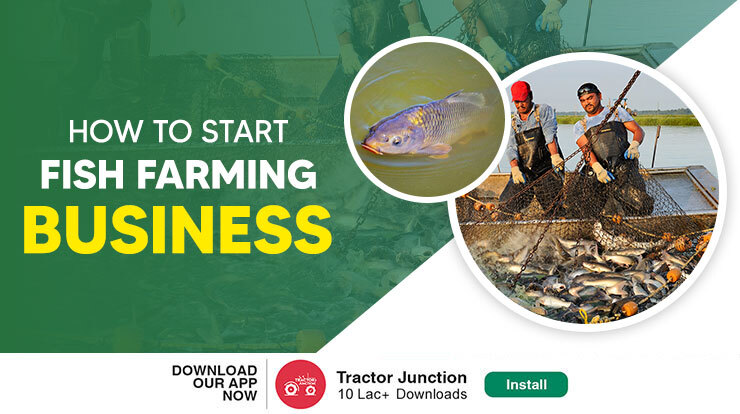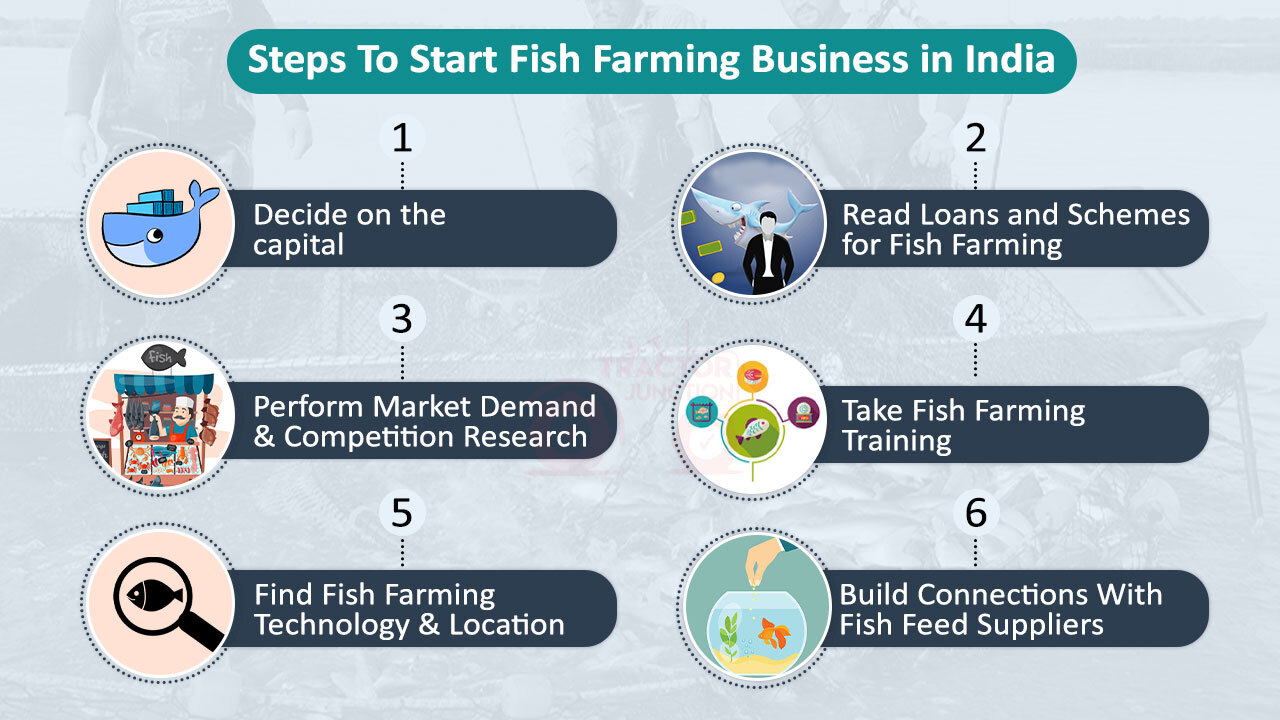
Did you know that India globally is the 3rd Largest fish producer, accounting for 7.96% of the market share in global food production?
And for marginalised and lower strata communities, fish farming is the ultimate source of income and livelihood. Around 28 million people in India are involved in fish farming and allied activities.
With such vast exposure, India’s export earnings from the fisheries industry are approx. Rs 334.41 billion. And with Catla fish cultivation, farmers can earn a revenue of Rs. 100,000 per acre per year, which can go up to Rs. 1,50,000/acre, p.a. if pursued properly.
If you are considering starting fish agriculture in India, let’s help you understand the following:
- What is fish farming?
- Advantages of Fish Farming
- Types of Fish Farming
- 6 Steps on How to Start Fish Farming in India
- Is Fish Farming profitable? Exact Earnings
What is Fish Farming?
Fish farming is the process of commercial breeding and rearing of fish, generally for food consumption or ornamental purposes.
Tilapia, Salmon, Carp, Shrimp, and Trout are the few high-selling fish species that can give huge returns.
Advantages of Fish Farming
Fish farming helps to speed up the supply of fish to keep up with the demand as compared to traditional methods of fishing and breeding through oceans that are often time taking. Fish are rich in protein and thus have high demand, which in tandem increases the fish prices and scope of earning more margins. So the profitability of fish farming is evident. Plus, fish farming helps meet fish-related products as well in various industries.
Types of Fish Farming in India
Aquaculture has two types — Brackish water aquaculture and freshwater aquaculture. In freshwater Aquaculture, freshwater fishes are cultivated, such as Catla, Magur, Rohu, and Carp. This farming also involves ornamental fish farming and freshwater pearl culture.
Is Fish Farming Profitable? Know How Much You Can Earn
Fish farming is an in-demand business as people eat almost 42 pounds of fish on average. Also, fishes are rich in protein and nutrients and are often consumed as a food source by the majority of Indian consumers.
The amount of profit on fish farming is huge, given your small investments. Moreover, by investing just Rs. 25,000, the farmers or fisheries can expect to earn up to Rs. 1.75 lakh – Rs. 2 lakh annually.
Note that: Variables that can impact Profit in Fish Farming in India
While considering fish farming, the variables like water resources, temperature, feeding sources and costs, pond types, and other operational and selling costs can vary your potential earnings from profitable fish farming.

Also Read – किसान ने मछली पालन से 8 माह में की 20 लाख रुपए की कमाई
How to Start Fish Farming in India? Get Started in Just 6 Steps
Starting a fish farming business requires some initial investment, technical training and resources. Here are easy steps on how to start a fish farming business in India.

Step 1 – Decide on the capital
For every business, deciding capital is imperative. Also, to identify the cost of starting this business, you must do extensive market research to see the target market and competition in the same area. And must identify the actual costs required to procure the raw materials and run the business.
Here are a few types of costs you would need to oversee:
- Costs related to infrastructure or area where you will culture or rear the fish. Such as fishing tanks or artificially curated man-made ponds or structures.
- Types of fish you would be rearing in your fish farm.
- And other variable costs related to buying fish feeds, electrical or water resources, labour costs, and other resources needed to pursue business activities.
Step 2 – Explore Loans and Schemes for Fish Farming
Chhattisgarh government has given fish rearing and culture the status of Agriculture. Also, the Government of India is now providing concession of water and electricity bills and some interest-free loans to pursue this fish farming.
The government of India has initiated Pradhan Mantri Matsya Sampada Yojana to regulate a comprehensive framework and eliminate infrastructural gaps in the fisheries sector.
Top 4 Government Fish Farming Schemes In India
1. 60% subsidy will be available for fish farming, know how to take loan from bank
2. Government will get up to 75 percent subsidy on fish farming
3. Up to 60 percent subsidy will be given from the government for prawn farming
4. Matsya Sampada Yojana: 60 percent subsidy for fish farming. Apply now
Here are a few loan schemes offered by private banks, NBCs and Government banks that can be utilise to pursue this farming type.
- SBI’s Pradhan Mantri Mudra Yojna (PMMY)
SBI is offering term loans up to Rs. 10 lakhs @10.75% per annum to help individuals gain employment opportunities and livelihood in agriculture or allied activities. The loan is credited by lending institutions such as commercial banks, RRBs, small finance banks, MFIs and NBFCs.
- Axis Bank Kisan Matsya Loan
Axis bank offers a Kisan Matsya loan to help farmers cultivate fresh/brackish water fish or prawns. The minimum loan amount is Rs. 25,001, and the maximum loan limit is Rs.1,50,00,000. However, the farmer should have 2 acres of own land/ water spread area pan India. And if residing in West Bengal and Odisha, a minimum of 1 acre of land is require.
Step 3 – Perform Market Research for Demand, Supply & Competition Analysis
You can perform market research in 3 different areas:
- Economy Level – Understand the purchasing power of people, know inflation & deflation in the economy and observe the factors that can impact the purchasing intent of buyers.
- Industry Level – Understand what the fish farming industry looks like, what it entails, the costs, profitability, and which marine resources are in huge demand.
- Business Level – Understand what kind of fish culturing and rearing will be fruitful and what size of business you would like to start and scale with.
Along with all these, understand your competitors. Know what added advantage they have. Moreover, figure out the demand and supply ratio in the fish farming market.
Step 4 – Invest in Fish Farming Training in India
You can learn about fish farming through various Government institutes. Also, these institutes aim to increase employment opportunities by providing free or less costly training on biofloc fish farming technology, management, handling operations of fish seed hatchery, aquarium construction, and deciding on the type of fish farming ponds.
Step 5 – Identify Location, technology and Scale
Know whether you want to invest in Marine aquaculture or freshwater aquaculture, based on your requirement and the area’s resources. You can use the Recirculatory Aquaculture System (RAS) (where water is recycled through filtration) a BFT (Biofloc Fishing Technology, where aggregates of algae, bacteria, or protozoa are used to improve water quality).
Ascertain whether your state or union territory provides any subsidiary, tax, and business benefits to pursuing this farming type or not.
If you are going for sustainable marine aquaculture, it is best to choose shallow coastal waters. If you are pursuing this farming in land-locked areas, you can go for the manmade types of ponds for fish farming and then decide the scale of business.
Step 6 – Built Connections with Suppliers, Logistic Partners & Buyers
To ensure your output reaches the right buyers in their preferred state, you need to have tie-ups with suppliers and logistic partners. Moreover, build connections with suppliers who deal in cold storage space to make your products reach freshly as practically as possible. Also, connect with suppliers of fish feeds and ancillaries. Create a value chain of the right suppliers and buyers.
You can adapt the D2C (Direct to Customer) model if you want to run every process internally rather than 3rd parties.
Conclusion
This was the ultimate guide to what fish farming is and how you can start with a fish farm with great profit margins.
Fish aquaculture is undoubtedly one of the best agriculture methods that is each day growing in demand and has a tremendous potential to scale. You can easily scale a high-end fish farming business with little investment, training, and resources.
Stay in touch with the Tractor Junction blog to get informed about more beneficial topics related to modern farming and agriculture practices that deliver a high yield.
Frequently Asked Questions
Que. What is fish farming in India?
Ans. Fish farming is the rearing, breeding, and transplantation of species of fish to meet food security needs. Moreover, the fish are rear commercially in fish tanks or other natural or manmade water confinements of choice.
Que. Is Fish Farming profitable?
Ans. Fish farming is profitable. By investing Rs. 25,000 into the business, the farmers can expect to earn Rs. 1.75 to Rs. 2 lakh annually.
Que. Which is the most profitable species for fish agriculture?
Ans. Tilapia fish agriculture is highly profitable as this species is highly sold and consumed and often eaten as shrimp or salmon.
Que. What is fish culture?
Ans. Fish culture is the process of species of fish rearing, breeding, and transporting different species to meet recreational, commercial, and scientific aspects.
Que. Which state is the largest fish producer in India?
Ans. Andhra Pradesh is the largest fish producer in India with a 27.4% market share, followed by West Bengal with a 13.8% market share. A.P. and West Bengal together fulfil India’s 41% fish production needs.
Que. What is integrated fish farming?
Ans. Integrated fish farming is a process where livestock and fish cultivation are performed simultaneously with regular farming activities that support each other. In addition, animal and agriculture waste gets directly/indirectly recycled & consumed by fish. Also, this method is quite economical for farmers and ecological as it conserves the environment.
Que. What is organic fish farming?
Ans. Organic fish farming is a process where organic pesticides, ecosystems, and treatments for aquatic life are adopted.
Que. What is composite fish farming?
Ans. Composite fish farming is a process of gaining a high yield from a pond/reservoir by rearing more than one type of compatible fish. Almost 5-6 species of fish can be reared together, increasing the survival rate of fish.
Que. What are important fish farming equipment?
Ans. Pond liners, pond pumps, water testers, aerators, fish feeding machines, and handling and grading tools are a few important fish farming equipment.
Que. What is pond fish farming?
Ans. Pond fish farming involves rearing finfish and shellfish in enclosed spaces or artificially created ponds. The water in these ponds can source from the canal, rainwater, bore well or else.
Related Blog
How to Start Honey Bee Farming in India
Watermelon Farming Business Ideas
Pineapple Farming in India
